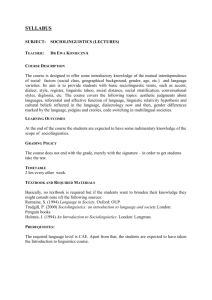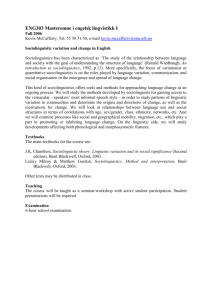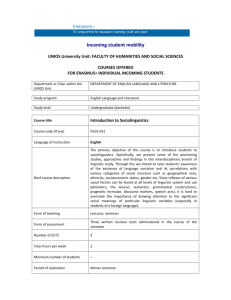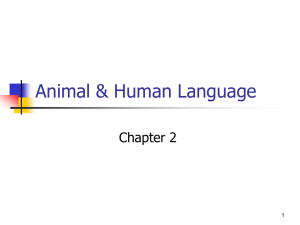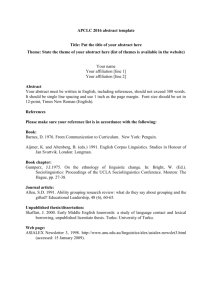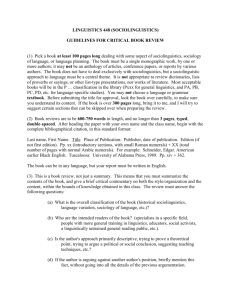Chapter Seven Language, Culture and Society
advertisement
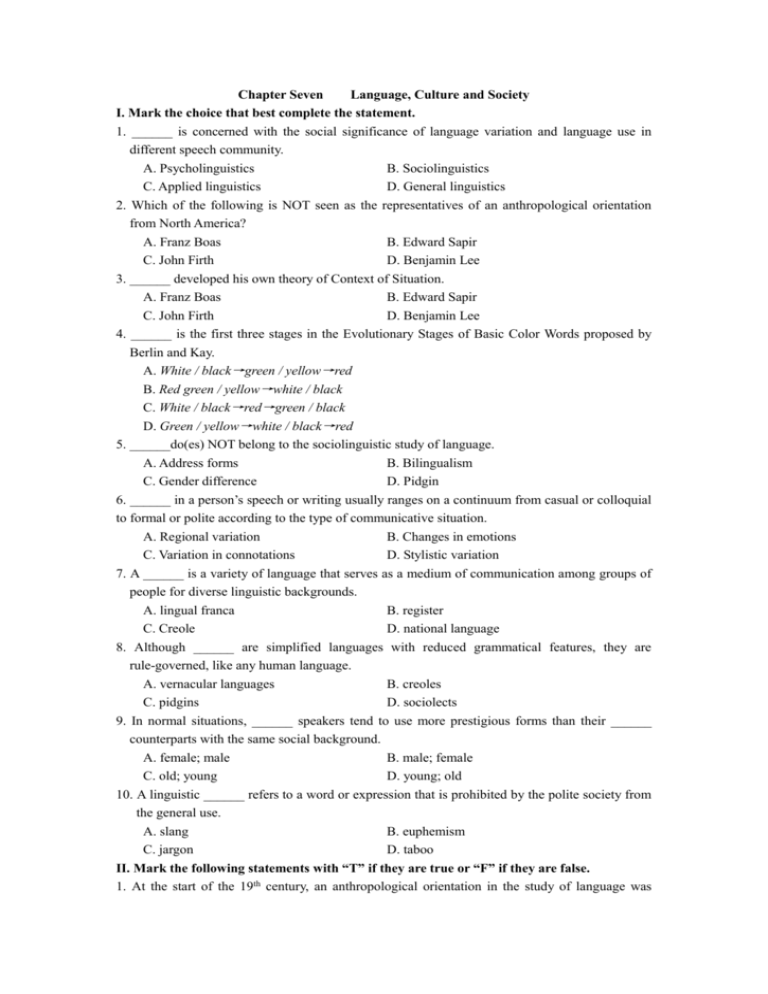
Chapter Seven Language, Culture and Society I. Mark the choice that best complete the statement. 1. ______ is concerned with the social significance of language variation and language use in different speech community. A. Psycholinguistics B. Sociolinguistics C. Applied linguistics D. General linguistics 2. Which of the following is NOT seen as the representatives of an anthropological orientation from North America? A. Franz Boas B. Edward Sapir C. John Firth D. Benjamin Lee 3. ______ developed his own theory of Context of Situation. A. Franz Boas B. Edward Sapir C. John Firth D. Benjamin Lee 4. ______ is the first three stages in the Evolutionary Stages of Basic Color Words proposed by Berlin and Kay. A. White / black→green / yellow→red B. Red green / yellow→white / black C. White / black→red→green / black D. Green / yellow→white / black→red 5. ______do(es) NOT belong to the sociolinguistic study of language. A. Address forms B. Bilingualism C. Gender difference D. Pidgin 6. ______ in a person’s speech or writing usually ranges on a continuum from casual or colloquial to formal or polite according to the type of communicative situation. A. Regional variation B. Changes in emotions C. Variation in connotations D. Stylistic variation 7. A ______ is a variety of language that serves as a medium of communication among groups of people for diverse linguistic backgrounds. A. lingual franca B. register C. Creole D. national language 8. Although ______ are simplified languages with reduced grammatical features, they are rule-governed, like any human language. A. vernacular languages B. creoles C. pidgins D. sociolects 9. In normal situations, ______ speakers tend to use more prestigious forms than their ______ counterparts with the same social background. A. female; male B. male; female C. old; young D. young; old 10. A linguistic ______ refers to a word or expression that is prohibited by the polite society from the general use. A. slang B. euphemism C. jargon D. taboo II. Mark the following statements with “T” if they are true or “F” if they are false. 1. At the start of the 19th century, an anthropological orientation in the study of language was developed both in England and North America. 2. The Firthian tradition was further developed by the founder of systemic-functional linguistics, Halliday. 3. The investigation of basic color vocabulary conducted by Brent Berlin and Paul Kay revealed the same findings as the Sapir and Whorf hypothesis. 4. There are ONLY two basic color words in the language Dani. 5. Kaplan claims that the structural organization of a text tends to be culturally specific. 6. There has been a maxim from Lakoff in sociolinguistics which claims that You are what you say. 7. William Labov’s objective for having the sociolinguistic investigation was to examine the relationships between speakers’ gender and their phonological variations. 8. Carl Rogers states that real communication takes place when we listen with understanding. 9. Linguistic universality is a property that all languages have, or a statement that holds for all languages. 10. The bond root –gate enjoys a rich productivity in American English, such as in the words Billygate, Debategate and Ricegate. III. Fill in each of the following blanks with an appropriate word. The first letter of the word is already given. 1. The social group isolated for any given study is called the speech c______. 2. As early as in the 1920’s, a school of a ______ study of linguistics came into being in England. 3. What Firth emphasized in the theory of Context of Situation is quite similar to a more updating sociological a______ in language use. 4. The experience and his study of Hopi, an American Indian language, helped Whorf develop his unique understanding of linguistic r______, which is widely known as the SAPIR-WHORF HPOTHESES. 5. The resurrection of a d______ view of linguistic inquiry, however, came into being in the 1960s. along with the development of sociolinguistics as an opposition to the dominant theory of Chomskyan linguistics. 6. Lakoff’s hypotheses suggest that here exists a women r______ in the language. 7. We can either classify sociolinguistic studies by means of hierarchical division, or alternatively, by means of an o______ categorization. 8. Hyme’s theory of Communicative C______ was introduced into language teaching in the middle of the 1970s. 9. Successful communication occurs when the two parties adopt a d______ dialogue pattern. 10. A pidgin typically lacks in i______ morphemes. IV. Explain the following concepts or theories. 1. Speech community 2. Communicative competence 3. Context of situation 4. Linguistic universality V. Answer the following questions briefly. 1. What might be the suggestive principles for cross-cultural communication? 2. What is Sapir-Whorf Hypothesis? 3. Summarize the important contributions of sociolinguistics. Chapter Seven Language, Culture and Society I. Mark the choice that best complete the statement. 1. ______ is concerned with the social significance of language variation and language use in different speech community. A. Psycholinguistics B. Sociolinguistics C. Applied linguistics D. General linguistics 2. Which of the following is NOT seen as the representatives of an anthropological orientation from North America? A. Franz Boas B. Edward Sapir C. John Firth D. Benjamin Lee 3. ______ developed his own theory of Context of Situation. A. Franz Boas B. Edward Sapir C. John Firth D. Benjamin Lee 4. ______ is the first three stages in the Evolutionary Stages of Basic Color Words proposed by Berlin and Kay. A. White / black→green / yellow→red B. Red green / yellow→white / black C. White / black→red→green / black D. Green / yellow→white / black→red 5. ______do(es) NOT belong to the sociolinguistic study of language. A. Address forms B. Bilingualism C. Gender difference D. Pidgin 6. ______ in a person’s speech or writing usually ranges on a continuum from casual or colloquial to formal or polite according to the type of communicative situation. A. Regional variation B. Changes in emotions C. Variation in connotations D. Stylistic variation 7. A ______ is a variety of language that serves as a medium of communication among groups of people for diverse linguistic backgrounds. A. lingual franca B. register C. Creole D. national language 8. Although ______ are simplified languages with reduced grammatical features, they are rule-governed, like any human language. A. vernacular languages B. creoles C. pidgins D. sociolects 9. In normal situations, ______ speakers tend to use more prestigious forms than their ______ counterparts with the same social background. A. female; male B. male; female C. old; young D. young; old 10. A linguistic ______ refers to a word or expression that is prohibited by the polite society from the general use. A. slang B. euphemism C. jargon D. taboo II. Mark the following statements with “T” if they are true or “F” if they are false. 1. At the start of the 19th century, an anthropological orientation in the study of language was developed both in England and North America. 2. The Firthian tradition was further developed by the founder of systemic-functional linguistics, Halliday. 3. The investigation of basic color vocabulary conducted by Brent Berlin and Paul Kay revealed the same findings as the Sapir and Whorf hypothesis. 4. There are ONLY two basic color words in the language Dani. 5. Kaplan claims that the structural organization of a text tends to be culturally specific. 6. There has been a maxim from Lakoff in sociolinguistics which claims that You are what you say. 7. William Labov’s objective for having the sociolinguistic investigation was to examine the relationships between speakers’ gender and their phonological variations. 8. Carl Rogers states that real communication takes place when we listen with understanding. 9. Linguistic universality is a property that all languages have, or a statement that holds for all languages. 10. The bond root –gate enjoys a rich productivity in American English, such as in the words Billygate, Debategate and Ricegate. III. Fill in each of the following blanks with an appropriate word. The first letter of the word is already given. 1. The social group isolated for any given study is called the speech c______. 2. As early as in the 1920’s, a school of a ______ study of linguistics came into being in England. 3. What Firth emphasized in the theory of Context of Situation is quite similar to a more updating sociological a______ in language use. 4. The experience and his study of Hopi, an American Indian language, helped Whorf develop his unique understanding of linguistic r______, which is widely known as the SAPIR-WHORF HPOTHESES. 5. The resurrection of a d______ view of linguistic inquiry, however, came into being in the 1960s. along with the development of sociolinguistics as an opposition to the dominant theory of Chomskyan linguistics. 6. Lakoff’s hypotheses suggest that here exists a women r______ in the language. 7. We can either classify sociolinguistic studies by means of hierarchical division, or alternatively, by means of an o______ categorization. 8. Hyme’s theory of Communicative C______ was introduced into language teaching in the middle of the 1970s. 9. Successful communication occurs when the two parties adopt a d______ dialogue pattern. 10. A pidgin typically lacks in i______ morphemes. IV. Explain the following concepts or theories. 1. Speech community 2. Communicative competence 3. Context of situation 4. Linguistic universality V. Answer the following questions briefly. 1. What might be the suggestive principles for cross-cultural communication? 2. What is Sapir-Whorf Hypothesis? 3. Summarize the important contributions of sociolinguistics.


